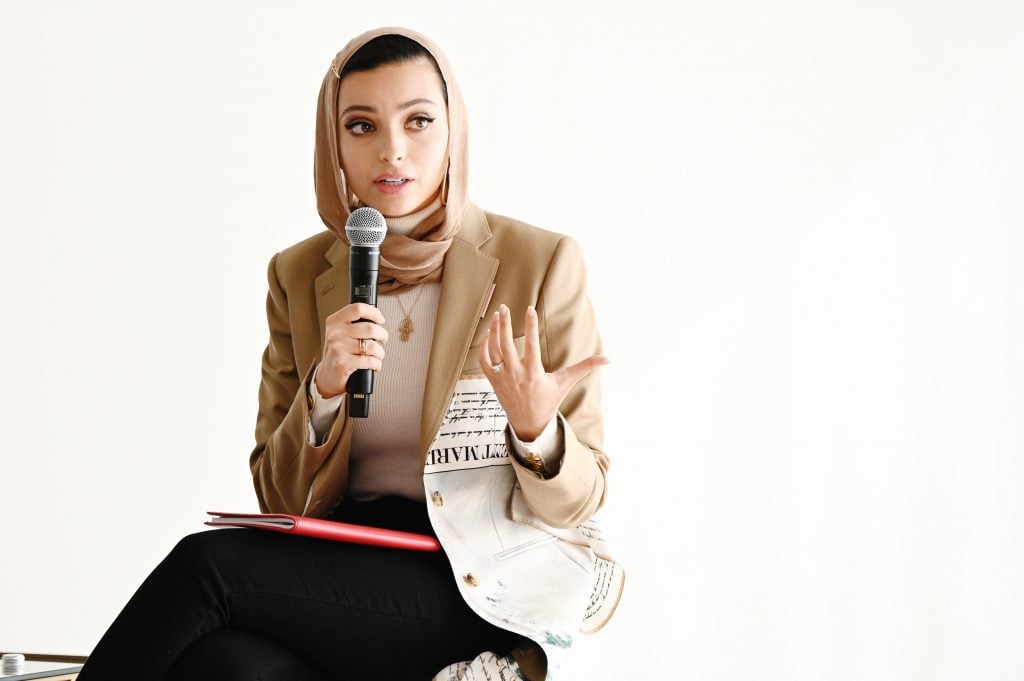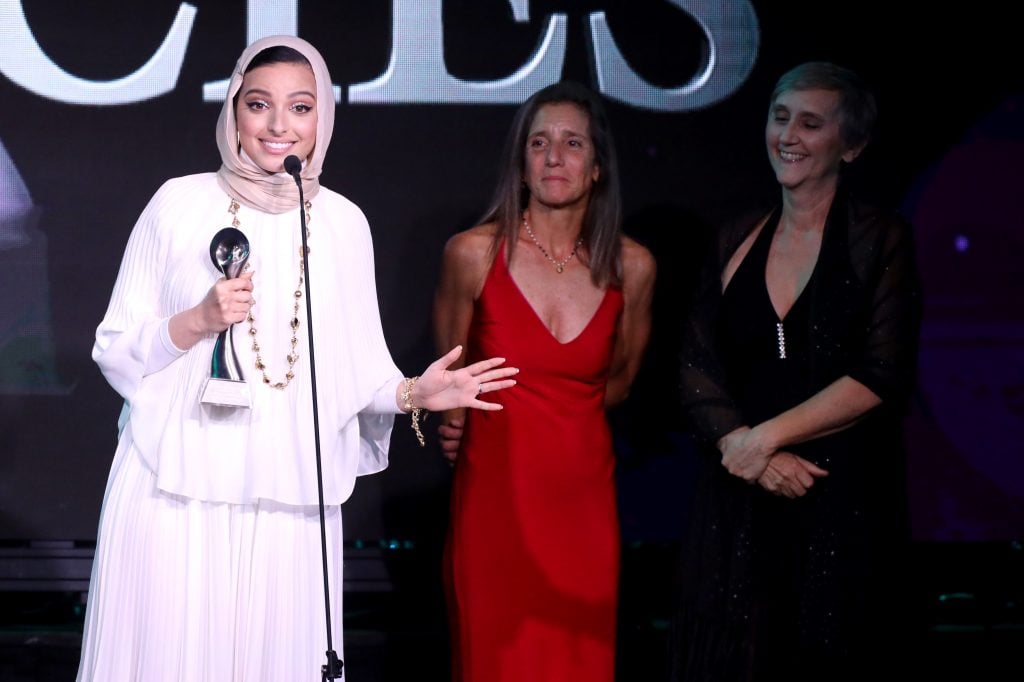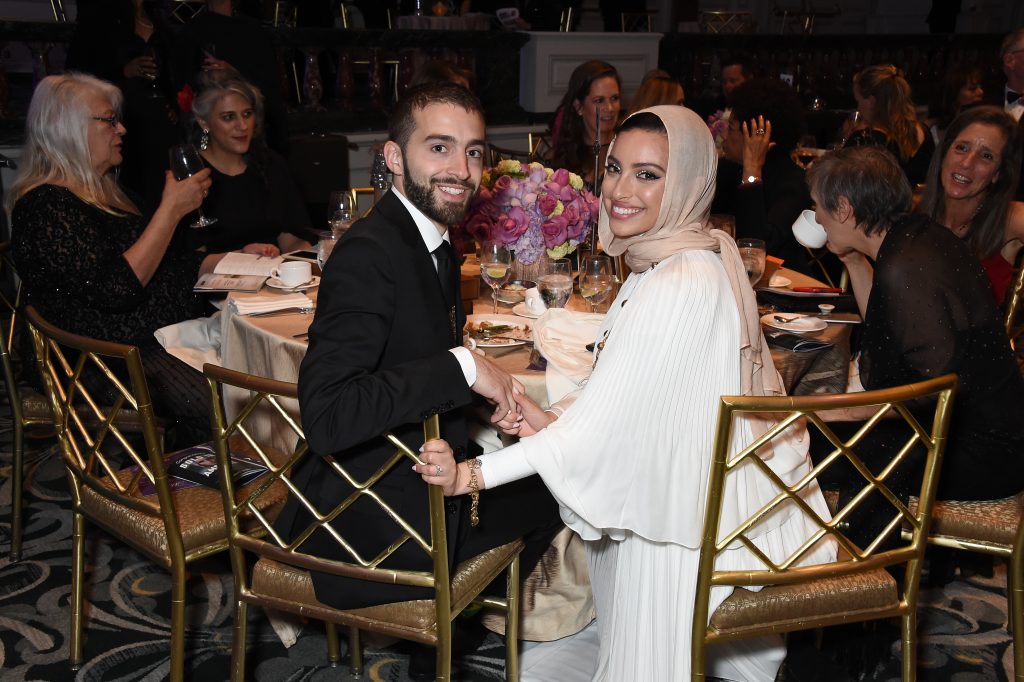People
‘Empathy Is a Superpower’: Journalist Noor Tagouri on How to Connect With Artists, and Why Risk-Taking Is Essential for Leaders
The award-winning journalist spoke to Artnet about the links between art-making, journalism, and activism.

The award-winning journalist spoke to Artnet about the links between art-making, journalism, and activism.

Noor Brara

In these turbulent times, creativity and empathy are more necessary than ever to bridge divides and find solutions. Artnet News’s Art and Empathy Project is an ongoing investigation into how the art world can help enhance emotional intelligence, drawing insights and inspiration from creatives, thought leaders, and great works of art.
Noor Tagouri, a 27-year-old Libyan-American journalist, is passionate about storytelling in all its forms. Tagouri, who began her career in broadcast journalism in 2012, has in recent years shifted her focus to writing, podcasts, filmed interviews, and public speaking, and has quickly become a voice of her generation, recognized for highlighting the stories of marginalized communities and underrepresented voices in America and beyond.
Her award-winning podcast series, Sold in America, which shined a light on sex trafficking in the U.S., was downloaded over 1.5 million times and won a 2019 Gracies Award for best Investigative Series. Her later projects include The Process, a video interview series in which she spoke with leaders and thinkers from various industries about the creative process. Many of her subjects, too, have been artists.
Following a whirlwind year in 2020, Tagouri is now taking on even more through her company, At Your Service, including launching a new podcast entitled Podcast Noor, a guided storytelling interview series that picks up where The Process left off. Along with her husband, Adam Khafif, she also recently founded Camp/us, a mountainside retreat for creative respites.
Tagouri spoke to Artnet News about her passion for art, how interviewing artists has impacted her career choices, and why empathy is central to her creativity.
Tell me a little about when you first became interested in storytelling as a craft.
It’s so funny, I’ve been watching old home videos from my childhood and there’s so much footage of me at three, four, and five years old telling my parents how to interview me. I would literally say to them, “Ask me this question and then I’ll answer it.” Or they’d put the camera in my face and ask me to “do my news.”
Story is really in my blood: my dad is a doctor, but he was basically a documentarian, because he spent all his time filming. So many people in my family, in fact, have preserved history through audio and video. It’s also a big part of Muslim tradition in general, and so many Muslim-majority cultures have perfected this craft, whether it be through story itself or the oral tradition. It’s how we survive.
I always knew this was what I was going to do even though I didn’t hear the term “journalist” until I was maybe 10 or 11. I didn’t ever seriously consider doing anything else. I did a lot of fashion design for a while, but I always loved it for myself. I was like, “I want to design things I’d wear, but I don’t want other people to wear what I design.” I was a stubborn designer, and that’s how I knew it wasn’t for me, because obviously you have to want people to wear your stuff. Now I think a little differently about it, but still I don’t think I’d ever be a fully-fledged designer, though I do love designing occasionally. That’s how I met my husband, Adam. He has a clothing line and we collaborated on two collections and it was a really amazing experience. That was pretty much it, though. It’s always been about storytelling for me.
For a moment, I thought I thought I needed to go to law school because… well, for one, I watched Legally Blonde [laughs] and also because I thought that going to law school will always help you if you want to be a journalist. At the same time, I don’t think journalism is something you have to go to school for. To be clear, I did go to school for it, but I don’t think you have to.

Tagouri speaks onstage at the 44th Annual Gracies Awards in 2019, hosted by The Alliance for Women in Media Foundation. Photo by Randy Shropshire/Getty Images for Alliance for Women in Media Foundation.
I agree with that. Some people go so far as to say that journalism school can ruin everything that’s naturally within you and that you should hold tightly to whatever those instincts are…
That’s actually really interesting to hear because I kind of might agree. I had to unlearn a lot of stuff that I learned in journalism school.
Right? You join this industry and you learn how it works and your greenness starts to go and often with it your confidence about whatever gives your work its own mark, for a little while anyway. And then if you still want to do this years later, after you’re more “established” or whatever you want to call it, I think you spend a lot of time unlearning the stuff people told you to break you in, the stuff they said you absolutely had to have to be here.
Exactly. And just learning how a journalist’s most important principle is objectivity and realizing, “Oh wait, all of my journalism professors were straight, cis, het white men.” And their definition of objectivity is in fact bias in itself.
On another note, I’ve been noticing through your Instagram that you’ve been doing the morning pages recently, which, for those who don’t know, is a technique from a book called The Artist’s Way by Julia Cameron that’s meant to help relieve writers and artists from feeling creatively blocked by doing three pages of stream-of-consciousness journaling every morning. It’s experiencing a mini-renaissance right now I think. I’m seeing a lot of people posting about it. I wanted to ask you about your experience with it and if you feel it’s helped you and your process.
Oh yeah. Morning pages has been such a safe haven for me to, sort of along the lines of what Julia Cameron says, remove the top layer of film off of the soup. But it’s also more than that. I’d never journaled before. I’ve always been too afraid to journal. I would try to do it and stop myself and now I realize, as I’ve been going back through all of my writing, that so much of it begins with, “I don’t write enough.” But no, I’ve written a lot. I was just putting myself down because I think writers put themselves under so much pressure to deliver in a certain way that isn’t natural to them.
Morning pages clicked for me because in those three pages, the whole idea was to give yourself grace and to make it okay to say, “I don’t know,” and to learn that there’s no such thing as writer’s block, really. It’s just being too afraid to commit something bad to paper. You have to get through the bad stuff to get to what’s good, and the two main takeaways I had from doing this is that it provides a direct connection and reason to access my inner voice. I’ve literally learned to access my inner voice, in earnest, and I write from there all the time now.
You’ve spent a lot of your career highlighting the stories of artists and creative types who beat to their own drum. That said, how has art—in all its varying forms—shaped or influenced your own career and the professional choices you’ve made? And what does art mean to you?
Art is anything and everything. It’s not just painting. I view art as just creative energy manifesting itself in connection to the divine. I do believe that creativity comes from a creator. It’s led me in how I tell my stories and what stories I choose to tell. In a more traditional sense, I’ve interviewed a lot of artists and I find them really exciting to interview because art—traditional art, in the way that we have learned about it—a lot of the time comes from a place of pain and confusion and trying to find something in yourself and I have experienced that, too. There have been situations where I’ve used art to try and locate myself.
For years, I was actually a performing poet and I’m just getting back to that. Morning pages also helps with that—I’ve been writing poems every day. I think art provides a bridge for connection. I know that if I am talking to somebody who has gone through this “artist’s journey,” then I’ll feel like I’m talking to a friend who has a similar understanding of what my experience has been. In a very general sense, that’s what art has taught me and how it’s guided me in my career.
What do you feel is a major learning you’ve taken away from your conversations with artists and other creatives?
With every person I’ve talked to—and many of them were leaders in their spaces—they never had the answers, they just took the risks. Everyone had the same story of, “I just took a chance on this thing, and I did it because it felt right.” We always assume these thought leaders have all the answers, but the reality is that no one will give us what we’re looking for in a better way than what we can give to ourselves. You just have to meditate on that.
We’ve been talking a lot about art and empathy recently—if art should hold a kind of moral stance, if art-making should inherently be in part about social responsibility. To what degree is empathy a factor in your work? How important do you feel empathy is to all creative work?
I think you can’t do creative work without empathy. And I think if you do, the impact isn’t there. For me, empathy is this superpower that I developed outside of journalism school, in the sense that it’s not one of those things that’s taught in school, which is pretty surprising because I think the whole idea of being a journalist is about getting people to trust you and tell you their truth and that’s a practice that’s rooted in empathy. I think that should be a requirement, because when we’re creating we have to know who we’re trying to serve, even if it’s ourselves. You need empathy to be able to connect.
Now it seems like it’s becoming a requirement, whether it’s in business or storytelling or art. The landscape of journalism itself is completely changing because of it. How many mistakes have we seen made in stories because of the lack of empathy, or because of someone’s choosing to remain in their comfort zone instead of learning about people? I just did my first Clubhouse conversation yesterday for Culture Club, and one of the things we discussed is how empathy is a requirement now. When we aren’t connecting with other people in that way, that’s when the harm is done and the misrepresentation happens.

Tagouri and husband Adam Khafif. Photo courtesy Getty Images
Beyond your work as a journalist, you’re an activist as well. What are some links you’ve found between art and activism, and the personalities in those two spaces?
Well, most recently I produced a conference called Doing Something About It with Phillip Lim and his team and we brought together artists and storytellers and traditional activists to talk about this exact topic. A lot of them were visual artists or art-adjacent people, whether it be painters or designers or curators, and every single one of them had a specific intention or a message or a reason for the art they were making that went beyond the work itself.
To me, the physical forms of activism that stick in my brain anytime I look at history are always photographs, paintings, graffiti… I see people’s soul being expressed through whatever medium is being used so I think they’re intrinsically linked. They have to exist together. I think most activists would also call themselves artists. At the core of what they’re doing is a form of expression.
What are you working on now?
We’ve been working on Camp/us, a mountainside campus upstate where Adam and I are building a campus for At Your Service, my storytelling company that includes podcasts, documentaries, and consulting. I’m working on producing a guided storytelling podcast called Podcast Noor. I’m also working on an investigative series that’ll be a documentary and podcast on how misrepresentation in media has affected American society. And then hopefully by the end of the year, I will have a speaking-in-public course out, which really came about as a result of realizing that there are other, more innovative ways to teach public speaking. It doesn’t have to be as traditional as it was.